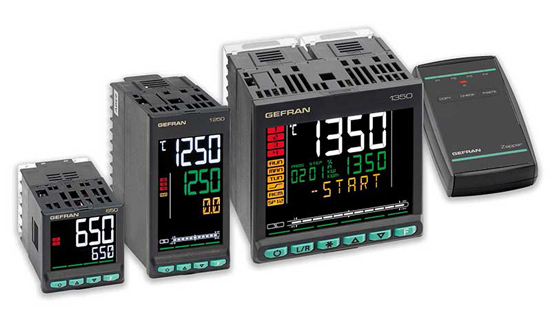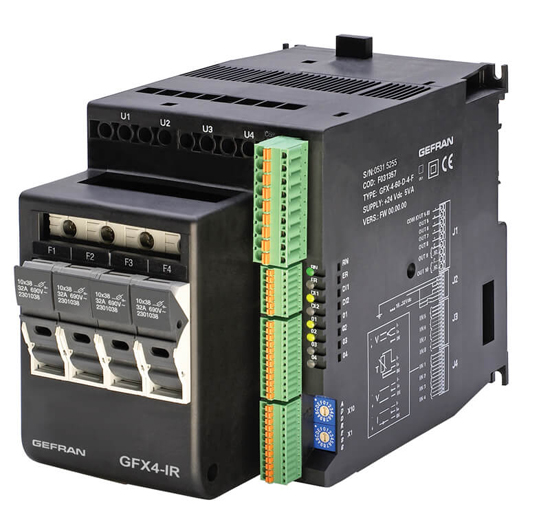
Gefran Products Work with a leader among Gefran distributors when you need Gefran temperature controllers and temperature sensors for monitoring and controlling your thermal processes. Some of the products we carry include PID temperature controllers, single-loop controllers, multi-loop controllers, industrial temperature sensors, and many industrial electric heaters.
Gefran is a global provider of custom, high-tech solutions for thermal applications. Accurate heat application requires PID controllers and heat sensors, both of which Gefran offers. They offer a diverse range of products, which can be divided into three basic categories:
- Sensor
- Automation
- Motion control
Sensors include RTD sensors and thermocouple sensors. Recorders, monitors and transmitters expand your options for monitoring heat levels.
Gefran automation products include state-of-the-art calibration instruments, programmable controllers and digital indicators to help you monitor the efficiency of your automated process.
Motion control and heat control products include positioners, multi- and single-loop controllers and process monitors.
Gefran Temperature Controllers

Gefran PID controllers (PID stands for proportional integral derivative) regulate a range of variables in your industrial process, including the following:
- Temperature
- Pressure
- Flow
- Speed
PID controllers regulate these variables through a control loop feedback system. A PID control system not only activates the heating element to increase the temperature to reach your target temperature, but it adjusts the temperature throughout the process to help avoid overheating. The goal of a PID controller is to reduce cumulative error to zero.
Gefran manufactures a number of temperature controllers to program and record temperature levels. Every controller is made with the highest levels of quality control, but the capabilities vary considerably.
Compare multi-loop performance models with basic models as you consider the most efficient controller for your process. Here are three examples that highlight the range of products available through Gefran distributors:
- 3850T: One of the most comprehensive controllers available, the 3850T convenient control and reporting of up to 16 individual loops. Use the data logger and batch report features to keep track of data in real-time. The set point programmer and function block give you critical ability to configure and control. Use the 7 inch touchscreen for easy adjustments and monitoring of your thermal system.
- 600: On the more basic side of Gefran manufacturing, the 600 uses four keys, two LED displays and four signal lights to control your thermal process. A universal main input allows you to connect the 600 with a thermocouple or thermistor, while the two presettable setpoints give you the control you need of a single PID loop.
- 1600V: Control three-step motorized valves with the Gefran 1600V. Another basic model with plenty of power, the 1600V is capable of creating up to four local setpoints for two available isolated digital inputs. Configure output function from the keypad for ease of use.
These three systems offer a sample of the many controllers and applications available through Gefran technology. State-of-the-art PID controllers not only offer you consistent temperature control but connect with the latest thermocouples and other temperature-monitoring devices to alert you to any unexpected changes.
Whether you’re heating a process liquid or providing warmth to your entire facility through a forced-air system, a PID controller takes charge of your industrial heater to give you the consistency and data-rich reports your company needs to move forward.
Single-Loop vs. Multi-Loop Controllers
Gefran distributors, like Hi-Watt, can help you order and maintain both single- and multi-loop controllers. Compare the advantages and disadvantages of each to see if you’re using the optimal setup for your operations.

Single-Loop Controllers
A single-loop controller is a basic option for your thermal process. It provides innovative functionality and precision controls, but without additional loops and cost. You can still enjoy alarms and detailed reporting functionality with a single-loop controller.
These controllers are typically front-of-panel products. This means they come with a visible display and require less time and energy to install and operate.
Multi-Loop Controllers
A multi-loop controller is usually installed behind the panel to support multiple loops and fieldbus options. These controllers are usually integrated with other devices, either within a single machine or throughout a plant. Unlike single-loop controllers, these are capable of connecting to multiple machines for a streamlined control system.
Create up to 16 PID loops with a multi-loop device. Each loop is independent and can be programmed individually or in conjunction with one another. If you have a system that requires a number of different loops, this type of controller can be more affordable than investing in multiple single-loop devices.
Check the compatibility of your controller with your machine, thermal device and temperature sensor. Gefran products are designed to operate universally with multiple connection options. There are some cases, however, when systems need to be programmed or updated to take advantage of all the features of your temperature controller.
Gefran Temperature Sensors
How do you know the process material is reaching the acceptable temperature programmed into your controller? Temperature sensor Gefran products read the most subtle changes in temperature and communicate this information with the PID controller. This process allows you to ensure an entire reservoir of liquid, solid material or areas of gas is heated to the proper temperature and at the proper rate.
Explore the two main types of temperature sensors available through Gefran distributors: thermocouples and resistance thermometers. Both can be used to achieve similar results, but there are situations that call for one over the other. The temperature level, process material and chosen controller can all affect the optimal temperature sensor for your situation.
Thermocouples
The goal of a thermocouple is to accurately measure temperatures. This could be in a focused point or the ambient temperature of the room. All thermocouples have two wires made of dissimilar metals. As one end is heated, the current flows in a thermoelectric circuit.
Any heat change causes a voltage change between the junction points. This change is proportional to the temperature difference at the end of the sensor, which can be translated into a temperature reading by a PID controller.
Thermocouples can be probes, wires or rods. They can be submerged in liquid, inserted into a closed system or left out to measure ambient temperature. There are many different sheathing materials to protect the two wires from a range of harsh industrial operations.
Resistance Thermometers
Resistance thermometers are similar in purpose but different in manufacturing and application. These sensors use a length of wire and a core of glass, ceramic or other materials. Most wires are made of pure copper, platinum, nickel or other material.
These temperature-reading devices are typically more accurate than thermocouples in situations with temperatures under 600 degrees Celsius. These low-temperature settings often require very precise and fast readings, which is where resistance thermometers offer an advantage over thermocouples.
Just like other heat-sensing devices, you can choose from a range of sheathing materials to protect your sensor in your particular thermal process. Sensors can be submerged or subjected to a wide range of heat levels, so it’s important to choose a quality sensor with a durable sheath.
Gefran PID controllers, sensors and other products work together to give you the data and control your plant deserves. Monitor your heat treatment or thermal application and explore the options for updating or replacing existing sensors and controllers.
